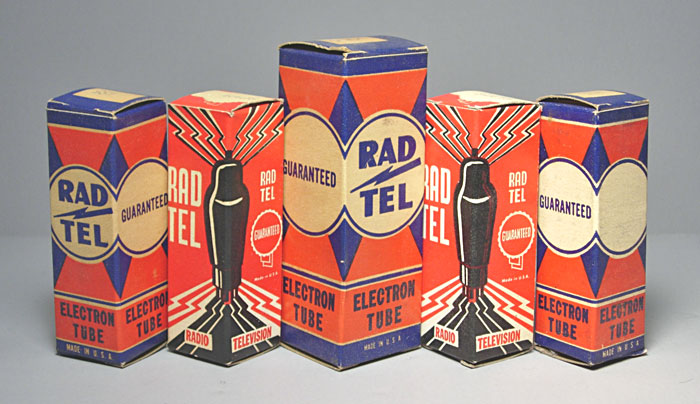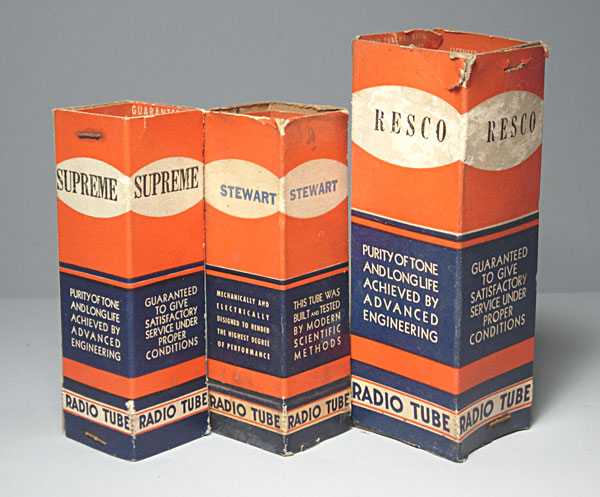|
Tube Boxes-The Rogues Gallery |
||
|
Featured on this page is a rogue's gallery of off-brand tube boxes, from the late 1940's through the 1960's. In boxes like these, you are certain to find tubes of questionable quality and pedigree. |
||
 |
||
|
The first picture highlights the notorious "Standard Brand" tube. The checkerboard-design boxes (second and third from the right) are the most often seen version. Many dealers sold tubes in these boxes, and the empty boxes were also sold in bulk quantities. It was normal for companies to make misleading or downright fraudulent claims for the quality of these tubes. It's an almost sure bet that when you find one of these boxes today, there will be a used tube inside. They were widely used by repairmen to "recycle" tubes. Some of these were tubes that were stripped from discarded radios or TV's. Others were working tubes needlessly replaced by dishonest repairmen to increase the profit on a repair job. A majority of these "Standard Brand" tube boxes will be found with handwritten tube type numbers on the top flaps, a sure indicator of a used tube. The condition of the tubes inside was entirely dependent on the honesty of the recycler. Some were tested and capable of satisfactory service, but many were not. |
||
 |
||
| The reselling of used
tubes by repairmen was something of a cottage industry, but there were
numerous shady companies organized to do this on a much larger scale.
Rad-Tel was one of the largest of these, and the boxes they used were
quite attractive, especially the ones with the tube image in black. Companies like Rad-Tel and many others obscured the real source of these tubes by scrubbing off the original markings, or painting over them (on metal tubes). Usually, new brand names were stamped on, but not always. After the end of WW-II, there was a literal flood of tubes with military markings onto the surplus market at very low prices. They were high quality tubes, of course, and they worked just as well after they were rebranded. Unfortunately, along with the war surplus tubes, many of the rebranded tubes that found their way back into the marketplace were used or substandard tubes from major manufacturers. Some were cheap imports, mostly from Japan. In the 50's, the Japanese electronics industry was still re-establishing itself after WW-II, and was far from achieving the level of quality that buyers expect from them today. These tubes were generally sold through mail-order catalogs, radio magazine advertisements, or by "radio-row" dealers in major cities. |
||
 |
||
|
This is a Rad-Tel advertisement from 1953 as it appeared in a popular radio magazine. As an example of how cheap these tubes were, the widely used 6V6-GT had a list price of $2.00 from RCA (the price a TV repairman would charge the customer). Distributors sold the RCA 6V6-GT for $1.20, but Rad-Tel's version sold for 39 cents! |
||
 |
||
| Names like "Reliable, "Premium Quality", and "Certified" were all meant to sound good to the customer, but they were likely to disappoint. | ||
 |
||
| These bargain brands are from the late 1940's. These generic boxes were personalized for the particular dealer that was selling them. RESCO (Radio Electric Service Company) was one of the larger electronics parts distributors at the time, and they are still very much in business. | ||

 |
||
| This is a sampling of some of the tubes that came in these boxes. On the left are two Rad-Tel tubes, and on the right are Supreme and Mytron tubes. All four have been rebranded. The Mytron tube is clearly used, as evidenced by the scratches in the base just below the name. These were put there by socket retainer springs which were frequently used in TV sets to keep the larger tubes from working their way out of the sockets. | ||
 |
||
|
Mytron tubes were rebranded used tubes. Omega appears to be a Japanese brand. |
||
 |
||
| NJRT stands for the New Jersey Radio Television Company, as seen on the center three boxes. The other two generic boxes promised to contain a radio tube. That much was probably accurate. | ||
|
|
||
 |
||
|
Alrad (aka Calrad) was a brand name for low quality Japanese tubes (and other electronic products like microphones) sold by mail-order dealers like Olsen Radio. The others are rebranded tubes. |
||
 |
||
|
This is a sampling of some tube boxes from prominent electronics mail-order and retail sellers. Lafayette was located on Long Island, NY, and Allied Radio was located in Chicago. Allied continues today as an industrial electronics supplier, and is located in Fort Worth, TX. Realistic is, of course, the brand name for Radio Shack products. |
||